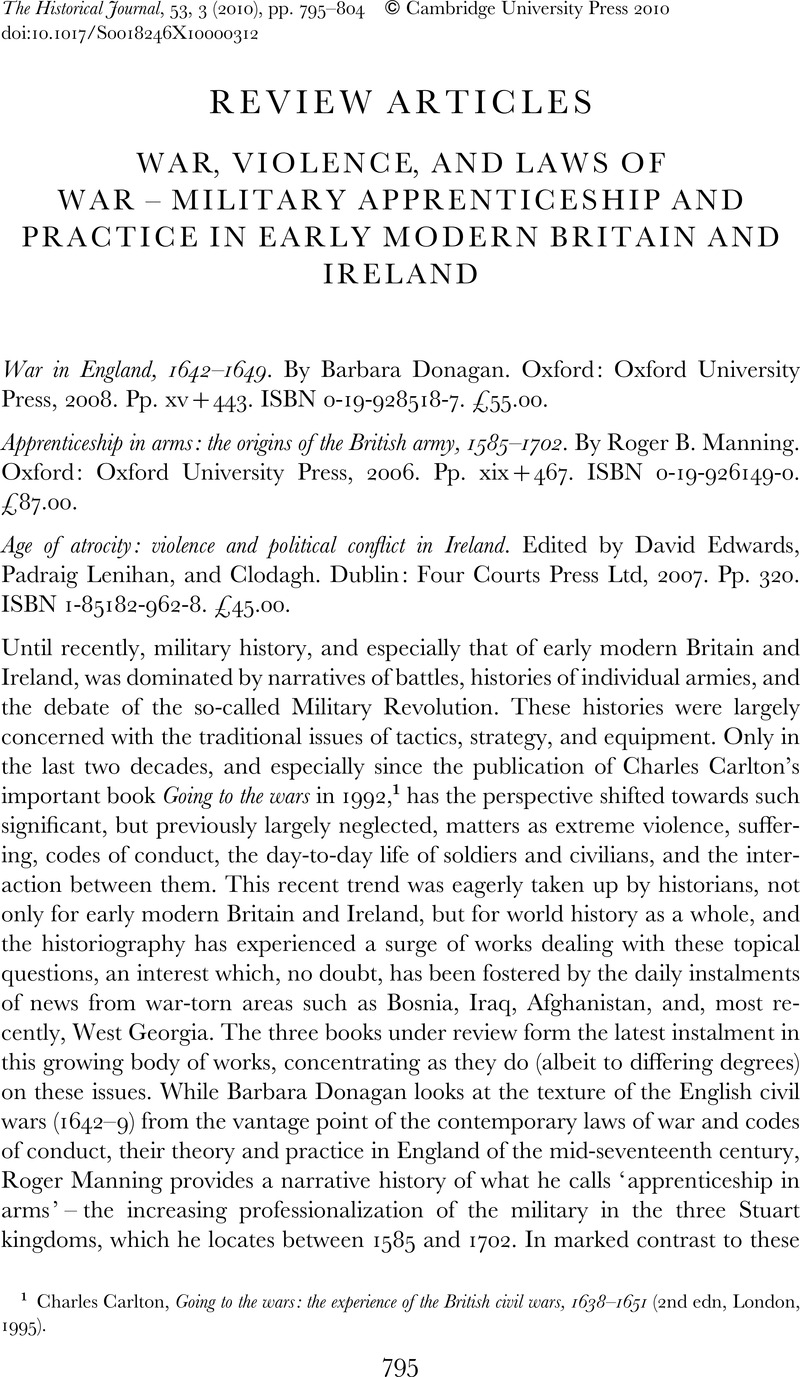No CrossRef data available.
Article contents
WAR, VIOLENCE, AND LAWS OF WAR – MILITARY APPRENTICESHIP AND PRACTICE IN EARLY MODERN BRITAIN AND IRELAND
Published online by Cambridge University Press: 17 August 2010
Abstract

- Type
- Review Articles
- Information
- Copyright
- Copyright © Cambridge University Press 2010
References
1 Charles Carlton, Going to the wars: the experience of the British civil wars, 1638–1651 (2nd edn, London, 1995).
2 Donagan, Barbara, ‘Atrocity, war, crime, and treason in the English civil war’, American Historical Review, 99, (1994), pp. 1137–66CrossRefGoogle Scholar; idem, ‘Codes and conduct in the English civil war’, Past and Present, 118, (1988), pp. 65–95; idem, ‘Prisoners in the English civil war’, History Today, 41 (Mar. 1991), pp. 28–35; idem, ‘The web of honour: soldiers, Christians, and gentlemen in the English civil war’, Historical Journal, 44, (2001), pp. 365–89.
3 Roy, Ian, ‘England turned Germany? The aftermath of the civil war in its European context’, Transactions of the Royal Historical Society, 28, (1978), pp. 127–44CrossRefGoogle Scholar.
4 David Stevenson has produced a large amount of work. Amongst his best-known works are the following: Revolution and counter-revolution in Scotland, 1644–1651 (London, 1977); Alasdair MacColla and the Highland problem in the seventeenth century (Edinburgh, 1980); Scottish Covenanters and Irish Confederates. Scottish–Irish relations in the mid-seventeenth century (Belfast, 1981).
5 Mark Stoyle, Soldiers and strangers: an ethnic history of the English civil war (New Haven, CT, and London, 2005).
6 These works are too numerous to mention. Please refer to the Royal Historical Society Bibliography for more information.
7 Amongst others see Edwards, David, ‘Beyond reform: martial law and the Tudor reconquest of Ireland’, History Ireland, 5, (1997), pp. 16–21Google Scholar; idem, ‘Ideology and experience: Spenser's view and martial law in Ireland’, in Hiram Morgan, ed., Political ideology in Ireland, 1541–1641 (Dublin, 1999), pp. 127–57.
8 For the most recent and exhaustive treatment of the issue, besides his numerous articles, see Nicholas Canny's Making Ireland British, 1580–1650 (Oxford, 2001).
9 James Burke, ‘Siege warfare in seventeenth-century Ireland’, in Pádraig Lenihan, ed., Conquest and resistance: war in seventeenth-century Ireland (Leiden, 2001), pp. 257–92; idem, ‘The New Model Army and the problems of siege warfare, 1648–1651’, Irish Historical Studies, 27, (1990), pp. 1–29; James Scott Wheeler, Cromwell in Ireland (Dublin, 1999); idem, The Irish and British wars, 1637–1654: triumph, tragedy and failure (London, 2002); McElligott, Gerard Jason, ‘Constructing and deconstructing Oliver Cromwell’, Bullán. An Irish Studies Journal, 5, (2001), pp. 132–7Google Scholar; idem, ‘Cromwell, Drogheda, and the abuse of Irish history’, ibid., 6 (2001), pp. 109–32; idem, Cromwell, our chief of enemies (Dundalk, 1994).
10 Amongst many other works, John Childs is the author of Armies and warfare in Europe, 1648–1789 (Manchester, 1982).




